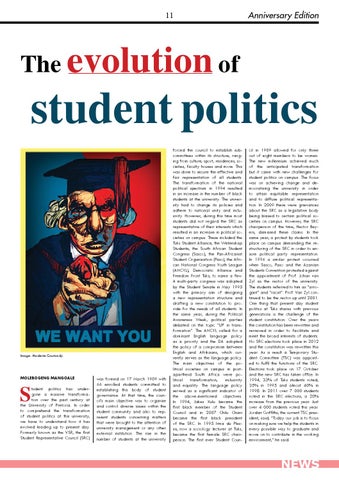11
Anniversary Edition
The evolution of
student politics
Image: Modeste Goutondji
MOLEBOGENG MANGOALE
S
tudent politics has undergone a massive transformation over the past century at the University of Pretoria. In order to comprehend the transformation of student politics at this university, we have to understand how it has evolved leading up to present day. Formerly known as the VSR, the first Student Representative Council (SRC)
was formed on 17 March 1909 with 66 enrolled students committed to establishing this body of student governance. At that time, the council’s main objective was to organise and control diverse issues within the student community and also to represent students concerning matters that were brought to the attention of university management or any other external institution. The rise in the number of students at the university
forced the council to establish subcommittees within its structure, ranging from culture, sport, residences, societies, faculty houses and more. This was done to secure the effective and fair representation of all students. The transformation of the national political spectrum in 1994 resulted in an increase in the number of black students at the university. The university had to change its policies and adhere to national unity and inclusivity. However, during this time most students did not regard the SRC as representative of their interests which resulted in an increase in political societies on campus. These included the Tuks Student Alliance, the Wetenskap Studente, the South African Student Congress (Sasco), the Pan-Africanist Student Organisation (Paso), the African National Congress Youth League (ANCYL), Democratic Alliance and Freedom Front Tuks, to name a few. A multi-party congress was adopted by the Student Senate in May 1995 with the primary aim of designing a new representation structure and drafting a new constitution to provide for the needs of all students. In the same year, during the Political Awareness Week, political parties debated on the topic “UP in transformation”. The ANCYL called for a dominant English language policy as a priority and the DA adopted the policy of a compromise between English and Afrikaans, which currently serves as the language policy. The main objectives of the political societies on campus in postapartheid South Africa were political transformation, inclusivity and equality. The language policy served as a significant indicator of the above-mentioned objectives. In 1994, Jakes Xulu became the first black member of the Student Council and in 2007 Chilu Chani became the first black president of the SRC. In 1995 Irma du Plessis, now a sociology lecturer at Tuks, became the first female SRC chairperson. The first ever Student Coun-
cil in 1909 allowed for only three out of eight members to be women. The new millennium achieved much of the anticipated transformation but it came with new challenges for student politics on campus. The focus was on achieving change and democratising the university in order to attain equitable representation and to diffuse political representation. In 2009 there were grievances about the SRC as a legislative body being biased to certain political societies on campus. However, the SRC chairperson of the time, Hector Beyers, dismissed these claims. In the same year, a protest by students took place on campus demanding the restructuring of the SRC in order to ensure political party representation. In 1996 a similar protest occurred when Sasco, Paso and the Azanian Students Convention protested against the appointment of Prof. Johan van Zyl as the rector of the university. The students referred to him as “arrogant” and “racist”. Prof. Van Zyl continued to be the rector up until 2001. One thing that present day student politics at Tuks shares with previous generations is the challenge of the student constitution. Over the years the constitution has been rewritten and reviewed in order to facilitate and meet the broad interests of students. No SRC elections took place in 2012 and the constitution was rewritten this year. As a result a Temporary Student Committee (TSC) was appointed to fulfil the functions of the SRC. Elections took place on 17 October and the new SRC has taken office. In 1994, 33% of Tuks students voted, 35% in 1995 and almost 40% in 1998. In 2011 over 7 000 students voted in the SRC elections, a 20% increase from the previous year. Just over 4 000 students voted this year. Jordan Griffiths, the current TSC president, said, “Today our job is to focus on making sure we help the students in every possible way to graduate and move on to contribute in the working environment,” he said.
NEWS
